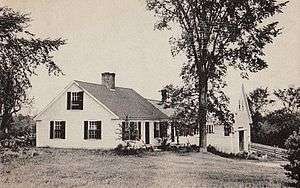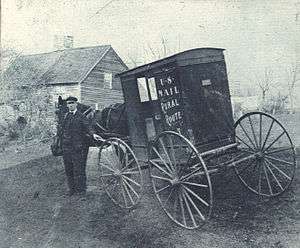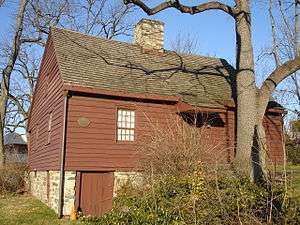Cape Cod (house)
A Cape Cod house is a low, broad, single-story frame building with a moderately steep pitched gabled roof, a large central chimney, and very little ornamentation. Originating in New England in the 17th century, the simple symmetrical design was constructed of local materials to withstand the stormy, stark weather of Cape Cod. It features a central front door flanked by multi-paned windows. The space above the 1st floor was often left unfinished, with or without windows on the gable ends.

The style enjoyed a boom in popularity and adaptation to modern needs in the 1930s-1950s, particularly with Colonial Revival embellishments. It remains a feature of New England homebuilding.
History

The Cape Cod cottage style house originated in the wood building counties of England and was brought to America by Puritan carpenters. The harsh climate of New England tested the pioneers' ingenuity, and by lowering the house and pulling its plan into more of a square footprint, they transported the English Hall and parlor house we call the Cape Cod cottage.[1] The style has survived and emerged as a 1- to 1 1⁄2-story house with wooden shutters and clapboard or shingle exterior. Using local materials – cedar for roofing and siding shingles, oak and pine for framing and flooring[2] – settlers built houses locally adapted to New England's extreme winter climate. Temperatures in January and February can drop to -20F, with snow accumulations often reaching several feet.[3] To fight the chill, they built massive central chimneys and low ceilinged rooms to conserve heat. The steep roof characteristic of New England homes minimized snow load. Finally, colonists installed shutters on the windows to hold back heavy winds.
The Reverend Timothy Dwight IV (1752–1817), president of Yale University from 1795–1817, coined the term "Cape Cod House" after a visit to the Cape in 1800. His observations were published posthumously in Travels in New England and New York (1821–22).[4] The style was popularized more broadly in a slightly more elaborate Colonial Revival variant popularized in the 1930s–50s, though traditional unornamented capes remain common in New England.

Colonial and Federal Capes (17th century–early 19th century)


Colonial-era Capes were most prevalent in the Northeastern United States and Atlantic Canada. They were made of wood, and covered in wide clapboard or shingles, often unpainted, which weathered grey over time. Most houses were small, usually 1,000–2,000 square feet in size. Often windows of different sizes were worked into the gable ends, with those of nine and six panes the most common.
The style has a symmetrical appearance with front door in the center of the house, and a large central chimney that could often accommodate back-to-back fireplaces. The main bedroom was on the first floor, with an often unfinished loft on the second. A typical early house had no dormers and little or no exterior ornamentation.
Framing and layout

The overwhelming majority of early capes were timber framed, with three bays formed by four bents. A few late examples of early capes used stud framing, and plank frame was also used.
The first Cape Cod houses fall into four categories: the quarter, half, three-quarter, and full Cape. The comparatively rare quarter cape is a single bay, usually a wider "outside" bay that would become rooms. It has a single door and a single window on the front, but is full depth. The half Cape is two bays, with a door to one side of the house and two windows on one side of the door; the three-quarter Cape has a door with two windows on one side and a single window on the other, while the full Cape consists of a front door in the center of the home, flanked on each side by two windows.[5] Otherwise, the three categories of early Cape Cod houses were nearly identical in layout. Inside the front door, a central staircase led to the small upper level, which consisted of two children's bedrooms.[5] The lower floor consisted of a hall for daily living (including cooking, dining, and gathering) and the parlor, or master bedroom.[6]
Some use a different naming system, and call the full-size version a "double cape", but this is used more often for an extended duplex structure.
"High post", also known as "kneewall", capes were originally an uncommon variant, but became more so into the 19th century, and became a feature of cape-derived vernacular architecture in the Midwest. The posts extend vertically past the first floor, increasing usable space on the second floor and simplifying joinery, at a cost of structural rigidity. The kneewall was often fenestrated with small low windows.[7]
Adaptations
Over the years owners doubled the full Cape and added wings onto the rear[6] or sides, typically single-storied. Dormers were added for increased space, light, and ventilation. A screened-in porch was sometimes added to one side of the home, rarely the front.
Colonial Revival (1930s–1950s)
Colonial Revival Cape Cod houses are very similar to Colonial Cape Cod houses, but some have the chimney at one end of the living room on the side of the house. Elaborate replicas were designed for the affluent, while architects such as Royal Barry Wills modernized the Cape for middle-class families[8] by including modern amenities that addressed demands for increased privacy and technology, including bathrooms, kitchens, and garages.[9] Adaptations proliferated throughout suburbs which emerged after World War II, and planned communities like Levittown, New York offered Cape Cod styled tract housing, particularly to returning soldiers.[10]
Today
1 1⁄2-story Capes remain a popular, affordable style on the housing market.[11]
See also
- Cape Cod style of lighthouse architecture
- Strawberry box houses, homes built with a simplified Cape Cod design
References
- William Morgan, The Cape Cod Cottage, Princeton Architectural Press, 2006
- Ballinger, Barbara. "Cozy Cape Cods." Realtor Mag 01 May 2007.
- "Winter in New England." New England Travel Planner.
- Timothy Dwight, Travels in New England and New York, William Baynes and Son, London, 1823
- Ross, Chuck. "Cape Cod-Style Houses: The Colonists' "Starter Homes"." HGTV Pro.
- Pilgrim Hall. Pilgrim Hall Museum, 18 May 2005.
- "New Hampshire Architectural Survey Manual" (PDF). Retrieved 4 December 2015.
- Wilson, Richard. The Colonial Revival House. New York, NY: Harry N. Abrams, Incorporated, 2004.
- HPRO_20174_5384502,00.html - "Royal Barry Wills & the History of the Firm." Royal Barry Wills Associates, inc
- Pilgrim Hall Museum, The Cape Cod House Archived May 27, 2010, at the Wayback Machine
- - "Cape Cod Home Architecture and Design Features." Rafter Tales.